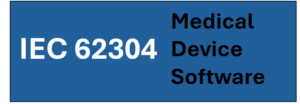ISO 62304

ISO/IEC 62304 is an international standard that specifies the life cycle requirements for medical device software. It provides a framework for the design, development, maintenance, and risk management of software used in medical devices or as standalone software, also known as Software as a Medical Device (SaMD).
The standard is intended to ensure that software used in healthcare environments meets stringent safety and quality requirements throughout its lifecycle, thereby helping manufacturers demonstrate compliance with global regulatory requirements, including those of the FDA, MDR, and IVDR.
Importance of Compliance
Compliance with ISO 62304 is critical for medical device manufacturers as software-related issues can pose significant risks to patient safety. The standard provides a structured approach to manage these risks effectively.
Non-compliance may result in device malfunction, regulatory penalties, or loss of market access. Meeting ISO 62304 requirements ensures product safety, reliability, and helps obtain CE marking or FDA approval.
Key Features of ISO 62304
– Software Development Life Cycle (SDLC): ISO 62304 defines requirements for all phases of the software development life cycle, including planning, analysis, design, implementation, testing, deployment, and maintenance.
– Risk Management: The standard integrates risk management activities to identify and mitigate software risks, which is crucial for minimizing potential hazards associated with software failure.
– Software Safety Classification: Software is classified into three safety classes (A, B, and C) based on the potential severity of harm in case of failure:
-
- Class A: No possible injury or damage.
- Class B: Non-serious injury is possible.
- Class C: Death or serious injury is possible.
– Maintenance and Change Control: Continuous software maintenance and proper change control processes are required to ensure the software remains compliant throughout its entire lifecycle.
Scope of Application
ISO 62304 is applicable to standalone software as well as software embedded in medical devices, including diagnostic software, therapeutic software, and health management systems.
It covers both Software as a Medical Device (SaMD) and software that is integrated within medical devices to provide critical functionality.
Steps for Compliance
- Software Safety Classification: Classify the software according to its potential impact on patient safety (Class A, B, or C).
- Software Development Plan: Create a Software Development Plan (SDP), including lifecycle phases, processes, and quality measures.
- Software Requirements and Design: Define software requirements and design specifications that meet safety and functional needs.
- Risk Management Process: Conduct a risk analysis to identify hazards and implement mitigations to reduce the risks to acceptable levels.
- Testing and Verification: Perform rigorous testing and verification activities to ensure the software meets all defined requirements.
- Maintenance Process: Establish a maintenance process to handle updates, bug fixes, and software modifications.
- Audits and inspections: Prepare your business on audits and inspections. Identify and correct potential discrepancies before the authorities visit.
Resources and Guidance
– ISO 62304 Document: Access the official ISO 62304 standard here.
Latest Updates and News
New Guidance Released: The International Medical Device Regulators Forum (IMDRF) recently released updated guidance on SaMD, which includes best practices aligned with ISO 62304 requirements
Contact Information
For help with 62304 compliance, email us at info@scengineering.dk or use the contact form.